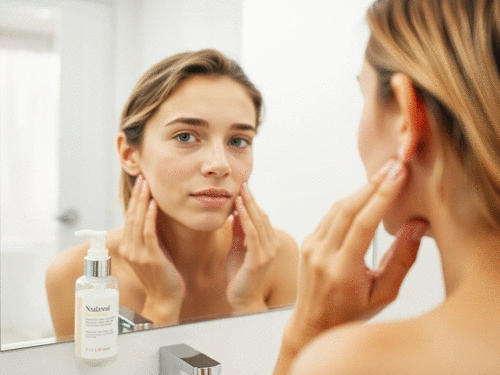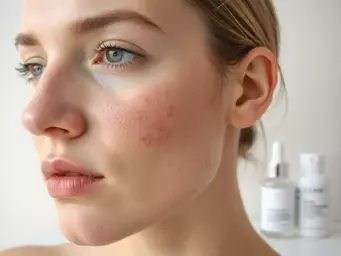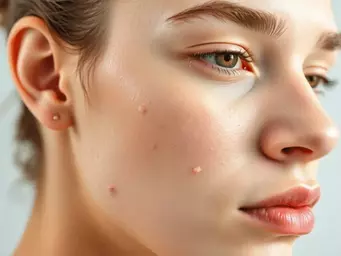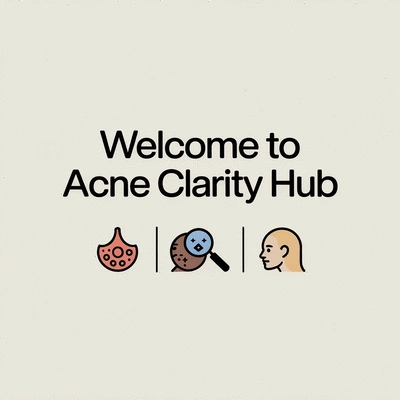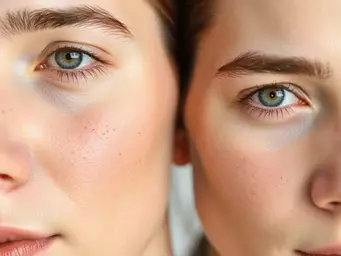As you navigate the complexities of skincare, understanding comedonal acne can be a game changer for your skin health. This often-overlooked condition deserves attention, and knowing how to manage it effectively can lead to clearer and healthier skin.
What You Will Learn
- Comedonal acne is characterized by blackheads and whiteheads, caused by clogged hair follicles.
- Blackheads are open comedones that darken due to oxidation, while whiteheads remain closed beneath the skin.
- Left untreated, comedonal acne can lead to severe skin issues and negatively impact self-esteem.
- A consistent skincare routine and lifestyle changes, such as a balanced diet and stress management, can significantly improve skin clarity.
Understanding Comedonal Acne: Types and Impact
This visual illustrates the two primary types of comedones and highlights the key reasons why addressing comedonal acne is important for overall skin health.
Comedone Types
Open Comedones: Blackheads
Clogged follicles exposed to air, appearing dark due to oxidation.
Closed Comedones: Whiteheads
Clogged follicles beneath the skin, appearing as small, white bumps.
Impact & Why It Matters
Skin Texture
Contributes to uneven skin texture if untreated.
Confidence
Persistent bumps can negatively impact self-esteem.
Potential for Infection
Clogged pores can become inflamed, leading to more severe issues.
Defining Comedonal Acne: What You Need to Know
Have you ever noticed small bumps on your skin that just don't seem to go away? You might be dealing with comedonal acne. This type of acne is often seen as less severe than inflammatory acne, but understanding it is crucial for your skin health. Let’s break down what comedonal acne is and why it matters.
Comedonal acne is primarily characterized by comedones, which can appear as blackheads or whiteheads. These are clogged hair follicles filled with excess oil and dead skin cells. While they might seem harmless, they can lead to larger skin issues if not addressed properly. Trust me, as a board-certified dermatologist, I've seen first-hand how understanding this condition can empower individuals to take control of their skincare.
Understanding Comedones: Types and Characteristics
Comedones come in two main forms: blackheads and whiteheads. Here’s what you need to know about each type:
- Blackheads: Open comedones that appear dark due to oxidation. For a deeper understanding of these skin lesions, the National Center for Biotechnology Information (NCBI) provides comprehensive information.
- Whiteheads: Closed comedones that remain beneath the skin, appearing as small, white bumps.
These types of comedones are frequently found on the nose, forehead, and chin, but they can appear anywhere on the body. Understanding these characteristics helps in identifying the right treatment and prevention strategies.
Why Comedonal Acne Matters: Impact on Skin Health
Comedonal acne may not cause pain or redness like its inflammatory counterparts, but that doesn't mean it should be ignored. If left untreated, comedonal acne can lead to more severe forms of acne and leave lasting marks on your skin. Here’s why it’s crucial to address this issue:
- Skin Texture: Comedonal acne can contribute to uneven skin texture.
- Confidence: Persistent bumps can impact your self-esteem and how you feel in your skin.
- Potential for Infection: Clogged pores can become inflamed, leading to infections. For more information on the progression of comedonal acne, DermNet NZ offers detailed insights into its impact.
By recognizing the importance of treating comedonal acne, you can take proactive steps towards achieving clearer skin. Remember, at Acne Clarity Hub, our goal is to equip you with the knowledge to make informed skincare decisions!
Exploring the Causes of Comedonal Acne
Understanding what triggers comedonal acne is key to managing it effectively. Various factors contribute to the formation of these pesky comedones, and it's essential to look at them holistically. Let's dive deeper into the causes!
Interactive Poll: Your Skin Journey
Now that we've covered the essentials of comedonal acne, we want to hear from you! Have you ever experienced comedonal acne? Share your thoughts below:
Summarizing the Journey with Comedonal Acne
Comedonal acne can often feel like a frustrating journey, but understanding its causes and symptoms is the first step toward effective management. As we’ve explored, comedonal acne primarily manifests through blackheads and whiteheads, which are formed from clogged pores. These comedones can arise from various factors, including excess sebum production, dead skin cells, and hormonal fluctuations.
Let’s highlight some key takeaways on what you need to remember about comedonal acne:
- Causes: Excess sebum, dead skin cells, hormonal changes, genetics, and lifestyle choices all contribute.
- Symptoms: Look for non-inflamed bumps that can be either blackheads or whiteheads, typically found on the face, back, and shoulders.
- Management: A consistent skincare routine combined with lifestyle modifications can significantly improve skin clarity.
By keeping these points in mind, you can better understand how to tackle your skin challenges head-on!
Final Thoughts on Treatment Options and Lifestyle Adjustments
When it comes to treating comedonal acne, the right approach can make all the difference. Starting with a personalized skincare routine that includes gentle cleansing and regular exfoliation is vital. Products containing salicylic acid or retinoids can help clear out the pores and prevent new breakouts.
Additionally, making lifestyle adjustments can greatly enhance your skin health. This includes choosing non-comedogenic products, maintaining a balanced diet, and managing stress. Here are some lifestyle changes to consider:
- Incorporate more fruits and vegetables into your meals.
- Stay hydrated by drinking plenty of water.
- Avoid smoking and limit alcohol consumption.
- Engage in regular physical activity to reduce stress.
Remember, every individual’s skin is unique, and what works for one may not work for another. Be patient with your journey, and don't hesitate to reach out for support!
Engaging with Your Skin Health: Next Steps
FAQs: Addressing Common Concerns About Comedonal Acne
Many people have questions about comedonal acne, and it’s essential to address these concerns to demystify the condition. Providing clear answers to these questions can empower individuals in their skincare journey!
Frequently Asked Questions About Comedonal Acne
Here are some common questions and answers to help you better understand and manage comedonal acne:
-
What is comedonal acne?
Comedonal acne is a type of acne characterized by the presence of blackheads (open comedones) and whiteheads (closed comedones). These are formed when hair follicles become clogged with excess oil and dead skin cells.
-
What causes blackheads and whiteheads?
Blackheads are open to the air and appear dark due to oxidation of the trapped sebum and dead skin cells. Whiteheads are closed beneath the skin's surface, appearing as small, white bumps. Both are caused by clogged hair follicles.
-
Why is it important to treat comedonal acne?
While often not as severe as inflammatory acne, untreated comedonal acne can lead to uneven skin texture, negatively impact self-esteem, and potentially progress to more severe inflamed lesions if the clogged pores become infected.
-
What are the best treatments for comedonal acne?
Effective treatments often include a consistent skincare routine with gentle cleansing and exfoliation. Products containing ingredients like salicylic acid and retinoids are commonly recommended to help clear pores and prevent new breakouts. For severe cases, a dermatologist might recommend professional treatments like light therapy or extractions, as detailed in this study on various acne treatments from PMC NCBI.
-
Can diet affect comedonal acne?
While direct links are still being studied, a balanced diet rich in fruits and vegetables, coupled with proper hydration, is generally beneficial for overall skin health and can help manage acne. Avoiding smoking and limiting alcohol consumption are also good practices.
Encouraging Consultation with Dermatological Experts
If you’re struggling with comedonal acne, I strongly encourage you to consult with a dermatologist. They can offer tailored advice and treatment plans based on your specific skin type and concerns. At Acne Clarity Hub, we aim to bridge the gap between the information you need and the expert guidance available to you.
Exploring Professional Skincare Solutions: Light Therapy and Acne Extractions
In some cases, professional treatments such as light therapy or acne extractions can provide additional help in managing comedonal acne. These methods can effectively clear stubborn comedones and improve overall skin texture. Always consider these options under the guidance of a qualified skincare professional to ensure they align with your individual needs!
Recap of Key Points
Here is a quick recap of the important points discussed in the article:
- Types of Comedones: Blackheads are open comedones that appear dark, while whiteheads are closed comedones that remain beneath the skin.
- Impact on Skin Health: Comedonal acne can lead to uneven skin texture, affect self-esteem, and increase the risk of infections if left untreated.
- Causes: Excess sebum production, dead skin cells, hormonal changes, genetics, and lifestyle choices contribute to comedonal acne.
- Management: A consistent skincare routine with gentle cleansing and exfoliation, alongside lifestyle modifications, can improve skin clarity.
- Consultation with Experts: Seeking advice from a dermatologist can provide tailored treatment options and guidance.

